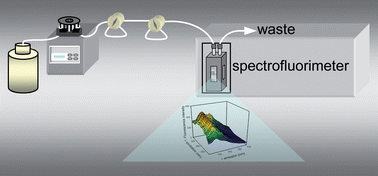This paper presents a novel approach for the simultaneous determination of two widely used fungicides in a very interfering environment, combining the advantage of a spectrofluorimetric optosensor coupled to a flow-injection system and the selectivity of second-order chemometric algorithms. The sensor is based on the simultaneous retention of thiabendazole and fuberidazole on C18-bonded phase placed inside a flow-cell. After the arrival of the analytes to the sensing zone, the flow is stopped and the excitation-emission fluorescence matrix is read in a fast-scanning spectrofluorimeter. Parallel factor analysis (PARAFAC) and unfolded and multidimensional partial least-squares coupled to residual bilinearization (U- and N-PLS/RBL) were selected for data processing. These algorithms achieve the second-order advantage, and are in principle able to overcome the problem of the presence of unexpected interferences. The power of U-PLS/RBL to quantify both fungicides at parts-per-billion levels, even in the presence of high concentrations of spectral interferences such as carbaryl, carbendazim and 1-naphthylacetic acid, is demonstrated. Indeed, U-PLS/RBL allowed us to reach selectivity using a commercial but non-selective sensing support. To the best of our knowledge, this is the first time the potentiality of the ‘second-order advantage’ is evaluated on a flow-injection system, using an unspecific supporting material and in the presence of three real interferences. Using a sample volume of 2 mL, detection limits of 4 ng mL−1 and 0.3 ng mL−1 for thiabendazole and fuberidazol were respectively obtained in samples without interferences. In samples containing interferences, the limits of detection were 17 and 1 ng mL−1 for thiabendazole and fuberidazol, respectively. The sample frequency, including excitation/emission fluorescence matrix measurements, was 12 samples h−1. The sensor was satisfactorily applied to the determination of both analytes in real water samples.

You have access to this article
 Please wait while we load your content...
Something went wrong. Try again?
Please wait while we load your content...
Something went wrong. Try again?


 Please wait while we load your content...
Please wait while we load your content...